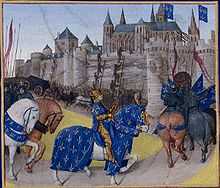Grandes Chroniques de France
The Grandes Chroniques de France is a royal compilation of the history of France, its manuscripts remarkably illuminated. It was compiled between the thirteenth and fifteenth centuries, beginning in the reign of Saint Louis, who wished to preserve the history of the Franks from the coming of the Trojans to his own time, in an "official" chronography whose dissemination was tightly controlled. It was continued under his successors until completed in 1461. It covers the Merovingian, Carolingian, and Direct Capetian dynasties of French kings, with illustrations depicting personages and events from virtually all their reigns.
The Grandes Chroniques de France had its origin as a French translation of the Latin histories written and updated by the monks of Saint-Denis, who were, from the thirteenth century, official historiographers to the French kings. As first written, the Grandes Chroniques traced the history of the French kings from their origins in Troy to the death of Philip II of France (1223). The continuations of the text were drafted first at Saint-Denis and then at the court in Paris. Its final form brought the chronicle down to the death of Charles V in the 1380s.
Sources for material on the reign of Charlemagne included the Historia Caroli Magni, also known as the "Pseudo-Turpin Chronicle" and the Vita Karoli Magni by Einhard. Other sources included Abbot Suger's Life of Louis IV.[1]

It survives in approximately 130 manuscripts, varying in the richness, number and artistic style of their illuminations, copied and amended for royal and courtly patrons, the central work of vernacular official historiography. Especially fine are the lavishly illustrated copies made for Charles V (BnF, Ms. Fr. 2813), Louis VII, illuminated by Jean Fouquet (1455-1460, BnF, Ms. Fr. 6465, above) and Philip the Good of Burgundy, now in the Russian National Library, Saint Petersburg (1457, above). For the first 150 years of the Grandes Chroniques's existence, its audience was carefully circumscribed: its readership was centered in the royal court at Paris, and its owners included French kings, members of the royal family and the court, and a few highly connected clerics in northern France. During this period, there were no copies of the work that belonged to members of the Parlement or the university community.[2]
Notes
| Wikimedia Commons has media related to Grandes Chroniques de France. |
- ↑ Geneviève Hasenohr and Michel Zink, eds. Dictionnaire des lettres françaises: Le Moyen Age. Collection: La Pochothèque. Paris: Fayard, 1992. pp. 294-7. ISBN 2-253-05662-6
- ↑ Bernard Guenée, "Les Grandes Chroniques de France : Le roman aux rois (1274-1518)," in La Nation, vol. 1, pt. 2, Les lieux de mémoire, ed. Pierre Nora (Paris, Gallimard, 1986), pp 189-214.
External links
- Les Grandes chroniques de France, edition by Paulin Paris
- Dagobert visitant le chantier de la construction de Saint-Denis.
- Hedeman, Anne D. 1991. The Royal Image: Illustrations of the Grandes Chroniques de France, 1274-1422 (Berkeley: University of California Press) The book covers five royal and fifteen nonroyal manuscripts of the Grandes Chroniques which exemplify different pictorial solutions to the problem of illustrating it.